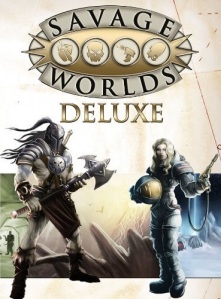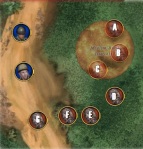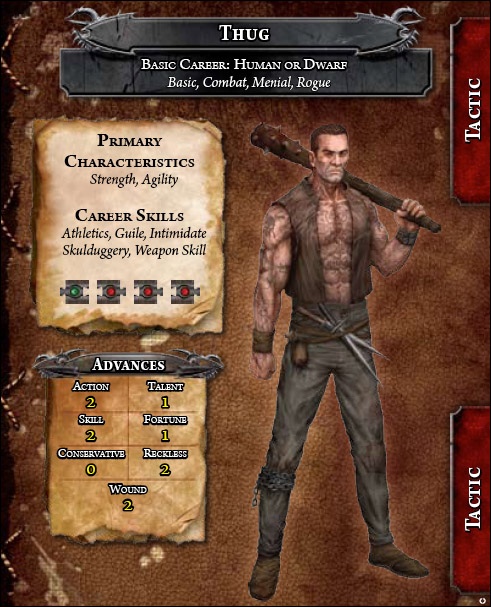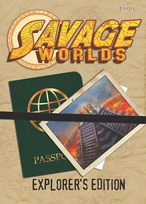Category Archives: Reviews
Predictions About a New Star Wars RPG
First off, I apologize for the delay in posting. Now that university is in full swing, I’ve had less time to write for this blog. In the future, you can expect at least one post each week (which may be standardized to a certain day of the week). Thanks for reading and sorry about the delay!
Earlier in the summer, Fantasy Flight Games announced that they had purchased the license to Star Wars card, role-playing, and miniatures games. Furthermore, they already had two games in the works: X-wing, a tactical minis game, and Star Wars: The Card Game, a cooperative card game. No word yet on a role-playing game.
First off, I have to say that I’m really intrigued by this announcement. I’m a huge Star Wars fan ever since I was a kid and saw the Special Edition of A New Hope in theaters with my dad. I’ve bought my share of the figures and Legos, played some of the board games, played most of the computer games, tried the trading card game, read many of the books (got Heir to the Empire signed by Timothy Zahn at Origins!), and even got a chance to talk to the guy who played Chewbacca (also at Origins a few years ago). Fun fact: according to him, Chewbacca didn’t get a medal for destroying the Death Star because Carrie Fisher wasn’t tall enough to give him one.
I have no doubt that they will eventually create a new Star Wars RPG, but I’m wondering a bit about what it will look like and I’ve been wanting to speculate about that on my blog. So far, Fantasy Flight Games has published the Warhammer 40k Roleplay line (consisting of Dark Heresy, Rogue Trader, Death Watch, and Black Crusade), Warhammer Fantasy Roleplay 3rd Edition, and a few other minor role-playing games. They are all fairly generic RPGs with a percentile systems and self-contained books, except for Warhammer Fantasy Roleplay. That one actually comes in a box set with color character sheets, several decks of cards for things like combat maneuvers, standup cardboard character figures, lots of little tokens and chips, and even a special set of dice. It’s all very beautiful and it’s nifty, but it’s also a bit expensive at nearly $100 (although one box gives everything that an entire group needs to have to play).
My prediction is that Fantasy Flight Games will make their Star Wars RPG similar to Warhammer Fantasy Roleplay 3rd Edition (henceforth abbreviated as WFRP3). Here are my predictions about what the final Star Wars RPG will look like when it is released.
- It will have similar production quality to WFRP3. There will be color cards and lots of new art depicting exciting things in the Star Wars universe.
- It will come in a box set like WFRP3. This will have the added draw of encouraging Star Wars fans to try a role-playing game if it’s all self contained like a board game.
- It will have fewer cards for combat maneuvers than WFRP3 (which included things like Shield Bash, Twin Shot, etc.). That’s less important in Star Wars where you’re just interested in shooting your blaster at the Stormtrooper or swinging your lightsaber.
- There will however still be cards for basic combat maneuvers. There will be cards for things like shooting, brawling, dodging, and other basic things.
- Jedi will definitely have combat cards. Things like lightsaber blaster bolt deflection, force powers, and other things will have cards to help players more easily keep track of things.
- It will use a career system like WFRP3. In that system, your character could transition from a thug to a tomb raider to a soldier. This fits for Star Wars where we have a farm boy turn into a pilot who then turns into a Jedi.
- It will be set in the Galactic Civil War era. It’s the most recognizable era and it’s the same era that their two upcoming board games will be released in. I believe further supplements will allow for play in other eras with The Old Republic being the first era released (to coincide with the MMO coming out) and the Clone Wars being the next one since the TV show is still going on.
- It will have special dice. The WFRP3 dice provide a unique way of describing the battle (e.g. he thrusts his sword and hits twice, but is fatigued by the effort). I think that would help work for the cinematic nature of Star Wars. It will be a different system of dice than the WFRP3 dice, but I predict that we will have something special like that.
- The box set will be priced at $60. I estimate this since I’m guessing there will be about as many components as Arkham Horror, a very elaborate board game that is priced at $59.95. Thus the role-playing game will be within the price point of the same people who buy their elaborate board games. Moreover, it will be less than WFRP3 because Warhammer fans are already spending a lot on armies and such, but a lower price point will be needed to pull in casual Star Wars fans.
Anyway, that’s my predictions for a Star Wars RPG from Fantasy Flight Games. When that does get released, I’d like to revisit these and see what things I predicted correctly. All in all, I’m eagerly awaiting it and I’m cautiously optimistic that they will do a good job with it.
Why Essentials Has Made Me Excited About D&D Again
Since I’ve talked a lot about Origins and Savage Worlds lately, I figured I would change it up a bit and talk about something else.
I’ve been burnt out on Dungeons & Dragons for a long time. Like many gamers, it was my first role-playing game (my first campaign was a 4th Edition game that started in the Fall of 2008). But over time, I just got really burnt out on it for a number of reasons, which I may go into more detail at some point.
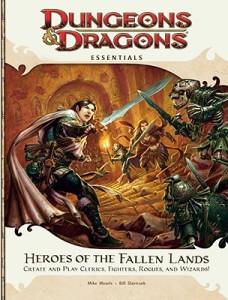 But during one of my Half Price Books runs, I was surprised to find Heroes of the Fallen Lands, a Dungeons & Dragons Essentials book that has character information for creating Clerics, Fighters, Rogues, and Wizards. For those who don’t know, Dungeons & Dragons Essentials is a repackaged, slightly simplified version of Dungeons and Dragons 4e. It’s also fully compatible with all the stuff published with regular Dungeons & Dragons 4e. Since the book was in good condition and half price, I joyfully picked it up. When I got home, I started reading it.
But during one of my Half Price Books runs, I was surprised to find Heroes of the Fallen Lands, a Dungeons & Dragons Essentials book that has character information for creating Clerics, Fighters, Rogues, and Wizards. For those who don’t know, Dungeons & Dragons Essentials is a repackaged, slightly simplified version of Dungeons and Dragons 4e. It’s also fully compatible with all the stuff published with regular Dungeons & Dragons 4e. Since the book was in good condition and half price, I joyfully picked it up. When I got home, I started reading it.
And you know what? I was actually excited about D&D again!
Why? Good question. First, I think a lot of it comes down to the psychological power of new packaging. I had grown to despise 4e in the form it was. Seeing something new, even if it had almost all the same rules as standard 4e, made it seem like it was a new product making a fresh start. I think that alone made me interested in trying it. I’ve even heard stories of people who scorned 4e when it came out but are happily embracing Essentials (much to the confusion of everybody who realizes they’re pretty much the same). All in all, new packaging seems to have been able to get rid of the preconceived notions people had. Good job, Wizards!
The first few pages succinctly explain what a role-playing game is and the most basic rules of D&D (even listing the “most important rule” and the other “two basic rules” that pretty much sum up how to play). I also liked how it said upfront how to do the most common combat maneuvers. For instance, Opportunity Attacks are described on Page 27, rather than being stuffed near the back of the book like in the original PHB. This whole section impressed me and I really felt a new player would be able to read it and get a good grasp on what this Dungeons & Dragons stuff was really about. Making it simple for newbies is a win in my book, even if I’m no longer a newbie.
Speaking of simplicity, I happened to like how at some levels the classes are just given a predetermined ability, making things much simpler and more consistent. At other levels, they are given a small list of powers to choose from. One of my big complaints about standard 4e was that there was so much splat (and the Character Builder was pretty much required if you wanted to use things beyond the PHB). Consequently, players tended to focus on their power cards and not on the story. This new system addressed that issue in a way I like and, at least during my cursory glance at the powers, there didn’t seem to be any must-haves or real stinkers. Perhaps someone who liked the crunch would be less happy with this, but to each their own.
In my mind, less is more, and this applies not only to powers, but also to gear. There are only three kinds of magic weapons: Magic, Defensive, and Vicious. Perhaps a tad limiting, but I happen to like the simple nature of it. And for what it’s worth, there are now 3 good magic items and 0 useless magic items. A very good ratio considering that in standard 4e the good stuff to useless stuff ratio was pretty poor.
The book as a whole was really well laid out. I think that a new player could read the book sequentially and not have to flip back at any point. Feats are organized by theme, like “Divine Devotion” and “Learning and Lore” which give a better idea of what a certain type of character might want to take. Essentials also takes great pains to ensure that you don’t miss any steps. Say you’re making a Rogue. There are large, 48 point headers saying what you get at each level. At Level 3 for instance, it says that you gain an extra use of your backstab ability and at Level 4, you gain the +1 Attribute bonus (which all classes get, but they want to make sure you don’t miss it). Simple, yet effective. Even the Character Sheet in the back of the book was much better laid out, and I truly felt I could fill it in by hand (having made nearly all of my previous 4e characters with the offline DDI Character Builder).
And at the end of the book, they have not only an index, but a glossary! So when you need to know what the “Deafened” status effect does (because really, who remembers?), you can look in the glossary and quickly find that a creature who is deafened takes a -10 penalty to Perception checks. I’m not sure it can get any simpler than that.
I haven’t played Dungeons & Dragons Essentials yet and I’m sure that it still has many of the flaws I’m accustomed to with 4e. But I’m amazed that a new cover, a reduction of content, and a more intuitive layout has made me excited to play D&D 4e again. I guess it goes to show that maybe RPG companies should spend a little bit more time thinking about the presentation and organization of their book and get more player feedback from both veterans and newbies.
The Joy of Savage Worlds
I should probably get this out pretty soon: I love all sorts of game systems, but there is one that I consistently turn back to: Savage Worlds. It’s certainly the game system that I’ve spent the most money on and I am constantly amazed by its simplicity and expandability.
One of the great things about Savage Worlds is that it isn’t tied to one sort of genre. Instead, it can be used for anything, from Pulp to Sci-fi, Fantasy to Supers, Westerns to Cyberpunk. Generally it favors cinematic action and it tagline is that the system is “Fast! Furious! Fun!” Personally, I’ve run it with pulp, pirates, zombies, Stargate SG-1, Deadlands (a western/horror setting), and Necessary Evil (a supers setting). In fact, there are only a handful of settings that I think wouldn’t work for Savage Worlds (someday I’ll write about that).
Pinnacle Entertainment Group calls Savage Worlds a “core system” rather than a universal system. The idea is that anybody running Savage Worlds will need a copy of the core rulebook. The current version is the Savage Worlds: Explorer’s Edition, although Savage Worlds Deluxe Edition should be coming out in the coming months, which has more explanations of the rules and a few minor changes.
The biggest strength is that combat works well and is fast. Initiative is done by dealing out playing cards each round and going from high to low. Combatants are generally divided into “Extras” (the generic mooks who are there to be cannon fodder) and “Wild Cards” (the people who are important enough to have a name). All the players are Wild Cards, as are the big villains, and they are more competent than the Extras. Combat also scales well for many combatants: I’ve had characters raid a Home Depot with 30 zombies without it bogging down badly.
Many officially published scenarios or settings add new setting rules, gear, Edges, or Hindrances to better express the setting, but additional material from one setting is usually not intended to be combined with another. Most of the time though, the core stuff is good enough. For the Stargate SG-1 conversion I wrote, I only added 2 new edges and 2 new races. The rest was already sufficiently covered in the rules. The only thing I really needed to do was create the gear, which took me about an hour to stat out all the weapons and gear from SG-1 and Atlantis!
One of the greatest things about Savage Worlds is that it not only covers standard combat, but also includes rules for magic, vehicles, chase scenes, and even mass battles. Rather than having a rule for everything, its intention is to create enough rules to provide a strong groundwork that is fairly realistic and relying on the GMs to handle the rest. The rules are streamlined to allow for quick and easy gameplay.
At the risk of sounding like a salesman, I’m going to point out that the best thing about Savage Worlds is probably its value: Savage Worlds Explorer’s Edition is a mere $9.99! An entire system, able to cover most settings, and containing rules for combat, magic, vehicles, chases, and mass battles, all for less than a meal at Applebees! I’ll admit that the price was the thing that hooked me first. And at that price, why not give it a try?
Savage Worlds isn’t perfect (another blog post topic for another day), and I don’t think that it’s the “system to rule them all.” But it does what it plans to do very well. I use it a lot and plan to talk about my experiences with it frequently here on this blog.

